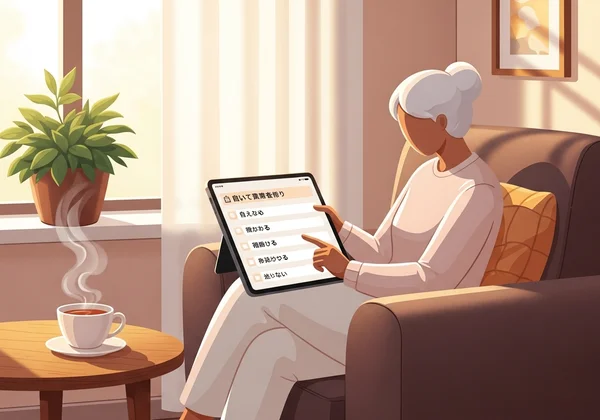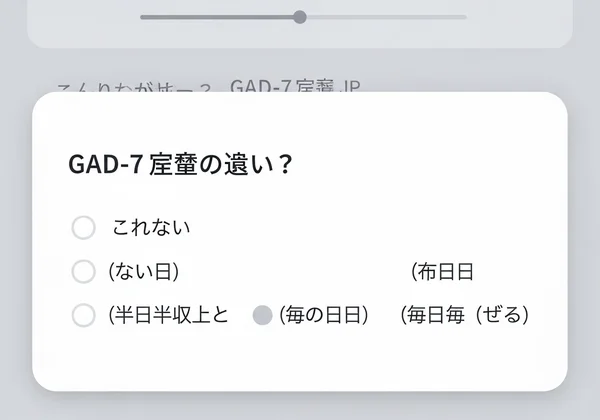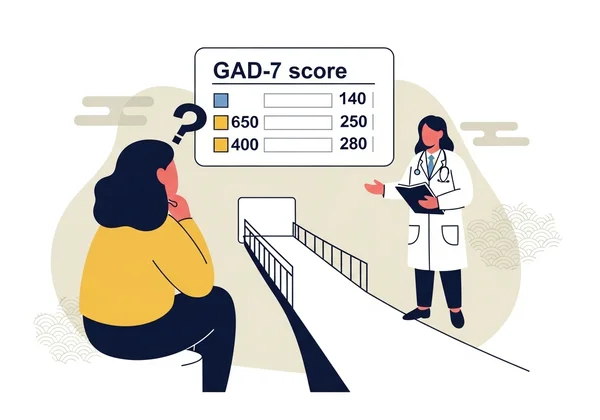GAD-7 Japanese Version: Your Guide to an Anxiety Self-Check & Scoring
In our fast-paced world, it's common to feel overwhelmed by worry or persistent unease. If you've recently found yourself grappling with lingering anxiety, you're not alone. Understanding these feelings is the first step toward managing them, but where do you begin? What is the GAD-7? This simple question can be the start of a journey toward clarity. For Japanese speakers, finding reliable, accessible resources can be challenging, which is why we're dedicated to providing the GAD-7 Japanese Version as a free, confidential, and scientifically validated self-assessment on our secure platform.
This comprehensive guide is designed specifically for Japanese users seeking to understand the GAD-7 test. We will walk you through what the test is, how to take it online, how to interpret your score, and what your next steps can be. Your mental well-being is important, and having the right tools in your own language makes all the difference. You can begin your assessment at any time.

What is GAD-7? A Guide for Japanese Users
The Generalized Anxiety Disorder 7-item (GAD-7) scale is a respected and widely used tool among healthcare professionals worldwide. It serves as a preliminary screening to help identify the presence and severity of symptoms related to generalized anxiety disorder. Originally developed by Drs. Robert L. Spitzer, Kurt Kroenke, Janet B.W. Williams, and Bernd Löwe, its effectiveness is backed by extensive research. Our platform provides a faithful Japanese translation, making this valuable resource accessible to millions more people.
Why is GAD-7 Important?
Taking a moment for a self-assessment can be an empowering act. The GAD-7 is important because it offers a clear, objective starting point. It's built on a scientific basis, ensuring the questions are relevant and meaningful. It provides an easy self-assessment that you can complete in just a few minutes from the privacy of your own home. Most importantly, it can aid in the early detection of anxiety symptoms, allowing you to seek support sooner if needed. It’s not about labeling yourself; it’s about understanding yourself.
The 7 Questions of GAD-7 and Their Meaning
The assessment consists of seven simple questions designed to evaluate the core anxiety symptoms. Each question asks you to reflect on how often you have been bothered by a specific issue over the past two weeks. These questions touch on key areas such as feeling nervous or on edge, not being able to stop worrying, worrying too much about different things, and having trouble relaxing. The structured format helps quantify feelings that can often seem vague and overwhelming, translating them into a clear, understandable score.
How to Take the GAD-7 Online Anxiety Test
Accessing a reliable mental health tool should be straightforward and stress-free. On our platform, we've designed the experience to be as simple and supportive as possible. Our platform ensures your privacy is protected every step of the way. The process is completely anonymous and requires no personal identification to get your score.
Taking the Test Online
Taking the GAD-7 test on our platform is incredibly simple. Just visit the homepage and select the Japanese language option. The process is as follows:
- Click to Begin: Start the assessment with a single click.
- Answer the 7 Questions: Read each question carefully and select the answer that best reflects your feelings over the last two weeks.
- Get Your Score: Once you submit your answers, you will receive instant results. Your total score will be calculated and displayed immediately.
This streamlined process removes barriers, allowing you to get the insights you need without delay. If you are ready, you can start your assessment now.

Utilizing the AI Personalized Report
While many online tools stop at providing a score, we offer something more. After receiving your initial score, you have the option to answer a few more background questions to generate a unique AI Personalized Report. This report is our core advantage, transforming a simple number into actionable advice. It provides deeper insights into your personal situation, highlighting potential strengths and challenges. Most importantly, it can help formulate a preliminary action plan with suggestions tailored to your responses, empowering you to take the next step with confidence.
GAD-7 Scoring and Understanding Your Results
Receiving a score is one thing; understanding what it means is another. The GAD-7 score is a simple sum of your responses, ranging from 0 to 21. This number corresponds to a specific level of anxiety symptom severity, giving you a clear benchmark. It helps you contextualize your feelings and communicate them more effectively, whether to yourself, a loved one, or a healthcare provider.
Score Ranges and Anxiety Levels
The GAD-7 scores are generally interpreted using established cutoff values. Here is a breakdown of what the different score ranges typically suggest:
- 0-4: Minimal Anxiety. Your symptoms are in a range that is generally not considered concerning.
- 5-9: Mild Anxiety. You may be experiencing some symptoms that cause mild distress.
- 10-14: Moderate Anxiety. Your symptoms are likely causing significant distress and may be impacting your daily life. Further evaluation is recommended.
- 15-21: Severe Anxiety. Your symptoms are causing severe impairment and distress. Seeking professional help is strongly advised.
Remember, these are guidelines. How you feel is what truly matters, and any level of distress is valid. You can understand your score in more detail on our website.
Next Steps: Consulting a Professional
It is crucial to understand that the GAD-7 is a screening tool, not a diagnosis. A high score does not automatically mean you have an anxiety disorder, and a low score doesn't invalidate your feelings if you are struggling. The results are best used as a conversation starter with a qualified professional, such as a doctor, therapist, or counselor. They can provide a comprehensive evaluation, make an accurate diagnosis, and work with you to develop a suitable treatment plan. Use your score as a tool to advocate for your own health.

Your First Step Towards Mental Well-being
Understanding your anxiety is a courageous and vital step toward improving your mental health. The GAD-7 provides a private, evidence-based way to check in with yourself and gain valuable perspective. By offering the GAD-7 in Japanese, we hope to make this tool accessible to anyone who needs it, providing a bridge to greater self-awareness and informed action.
Your journey is unique, and this is just one step. Whether your score is low, moderate, or high, you have taken a positive action by simply seeking information. Now, you are better equipped to understand your experiences and decide what comes next.
Take your first step towards mental well-being today. Try the free GAD-7 in Japanese on our secure platform.
Frequently Asked Questions About GAD-7 Japanese Version
What kind of diagnostic tool is GAD-7?
The GAD-7 is an anxiety screening tool, not a diagnostic one. It is designed to identify and measure the severity of common anxiety symptoms. A formal diagnosis can only be made by a qualified healthcare professional after a comprehensive clinical evaluation.
My GAD-7 results worry me. What should I do?
If your results are causing you concern, it is a sign that reaching out for support is a good idea. Use your score as a starting point to discuss your feelings with a doctor, psychologist, or licensed therapist. They can offer guidance and help you navigate the best path forward.
Is the AI Personalized Report Free?
The GAD-7 test and your initial score interpretation are completely free and always will be. The optional AI-powered personalized report is a unique feature we offer to provide deeper, actionable insights based on your specific answers.
How is GAD-7 different from PHQ-9?
This is an excellent question. While both are brief screening tools, the GAD-7 is designed to measure symptoms of anxiety, whereas the PHQ-9 (Patient Health Questionnaire-9) is used to measure symptoms of depression. They assess different conditions but are often used together by clinicians because anxiety and depression can frequently co-occur.
What age range is appropriate for GAD-7 Japanese version?
The GAD-7 was originally validated for use in adults. However, it is now widely used with adolescents as well. If you are concerned about a younger person, it is always best to have the results interpreted by a professional who specializes in child or adolescent mental health. You can find more resources and take the test on our site.